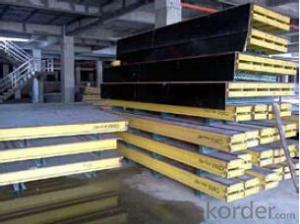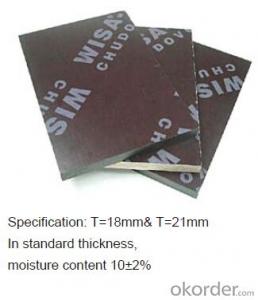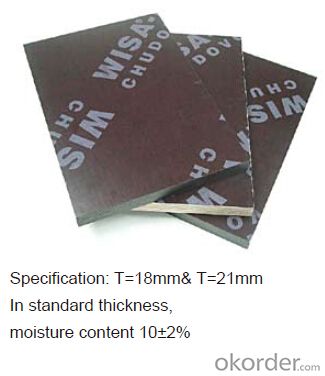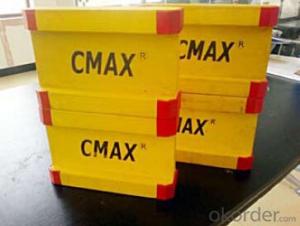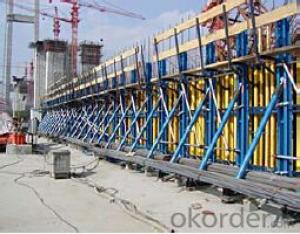Plywood Formwork systems for Formwork and scaffolding
- Loading Port:
- Tianjin
- Payment Terms:
- TT OR LC
- Min Order Qty:
- 50 m²
- Supply Capability:
- 1000 m²/month
OKorder Service Pledge
Quality Product, Order Online Tracking, Timely Delivery
OKorder Financial Service
Credit Rating, Credit Services, Credit Purchasing
You Might Also Like
Plywood --- make perfect concrete surface
WISA-Form Birch is a coated special plywood using in the formwork systems where high
requirements are set on the concrete surface and the times of reuses.
With CNBM timber beam & WISA plywood, the formwork is low weight but high load capacity, it is
widely used in construction.
Characteristics:
◆ Component with high standardization.
◆ Assembling in site, flexible application.
◆ Light weight, easy transportation and storage.
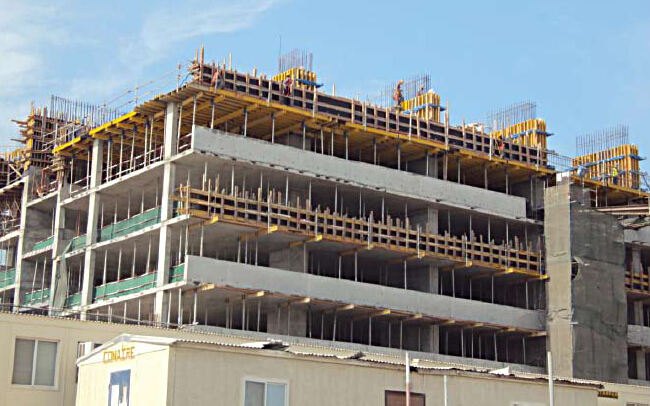
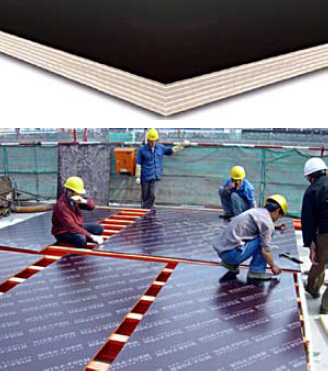
- Q: What are the different types of formwork release oils used with steel formwork?
- There are typically two types of formwork release oils used with steel formwork: petroleum-based oils and water-based oils. Petroleum-based oils provide excellent adhesion and protection against rust, but they can be flammable and may have a strong odor. Water-based oils, on the other hand, are non-flammable and have a low odor, making them more environmentally friendly. However, they may not provide the same level of adhesion and rust protection as petroleum-based oils.
- Q: What are the factors to consider when selecting steel formwork for a project?
- When choosing steel formwork for a project, there are multiple factors that need to be taken into consideration. To start with, the size and complexity of the project should be evaluated. The steel formwork should be able to accommodate the specific dimensions and requirements of the project. It is important to consider the shape and design of the structure, as well as any unique features or details that may necessitate customized formwork. The strength and durability of the steel formwork are crucial aspects to consider. It should be able to endure the weight and pressure of the concrete during pouring and curing. Desired characteristics include high load-bearing capacity and resistance to deformation. Additionally, the formwork should be able to resist rust and corrosion, particularly in areas with high levels of humidity or exposure to water. The ease of assembly and disassembly is another important consideration. Opting for steel formwork that can be quickly and efficiently put together and taken apart can save time and reduce labor costs. The formwork should have a user-friendly design, accompanied by clear instructions and requiring minimal tools for installation. Compatibility with other construction equipment and processes, such as cranes or concrete pumps, should also be taken into account. The reusability of the steel formwork is another factor to consider. If the project requires multiple pours or if there are future projects that could benefit from the same formwork, it is important to select formwork that can be easily dismantled, cleaned, and reused. This not only reduces waste and environmental impact, but also provides long-term cost savings. The availability and cost of the steel formwork should also be considered. It is crucial to choose a supplier or manufacturer that can deliver the required quantity of formwork within the project's budget and timeframe. Comparing prices and quality from different suppliers can aid in selecting the most cost-effective option. Lastly, safety should always be prioritized. The steel formwork should meet all necessary safety standards and regulations. It should be stable, secure, and capable of withstanding potential accidents or mishaps during the construction process. Additionally, the formwork should provide adequate protection for workers, such as guardrails or safety nets, to prevent falls or injuries. By taking these factors into account, the selection of steel formwork for a project can be carried out in an informed and efficient manner, ensuring the success and quality of the construction process.
- Q: How does steel formwork contribute to the overall sustainability of a construction project?
- Steel formwork contributes to the overall sustainability of a construction project in several ways. Firstly, steel formwork is highly durable and can be reused multiple times. This reduces the amount of waste generated during the construction process, as compared to traditional timber formwork which is typically discarded after only a few uses. By minimizing waste, steel formwork helps conserve natural resources and reduces the environmental impact of the construction project. Additionally, steel formwork is known for its strength and stability, allowing for the construction of more robust structures. This means that buildings constructed using steel formwork are likely to have a longer lifespan, reducing the need for frequent repairs or reconstruction. The longevity of steel formwork contributes to the overall sustainability of a construction project by minimizing the resources and energy required for maintenance and renovation over time. Moreover, steel formwork enables faster construction, as it can be easily assembled and disassembled. The efficiency and speed of steel formwork result in shorter construction periods, which in turn reduces the energy consumption and carbon emissions associated with construction activities. This is especially important in today's fast-paced construction industry, where reducing time on site is a key factor in achieving sustainable development goals. Furthermore, steel formwork provides a higher quality finish to concrete structures, which can contribute to the overall energy efficiency of a building. A smooth and precise finish achieved through steel formwork can reduce the need for additional insulation or cladding, thus reducing the energy required for heating or cooling the building. This not only benefits the environment but also improves the energy efficiency and comfort of the occupants. In conclusion, steel formwork contributes to the overall sustainability of a construction project by minimizing waste, increasing durability, reducing construction time, and enhancing energy efficiency. By choosing steel formwork, construction projects can achieve a more sustainable and environmentally friendly approach, benefiting both the immediate project and the long-term impact on our planet.
- Q: What are the different types of lifting systems used with steel formwork?
- Steel formwork in construction projects can be transported and installed using various types of lifting systems. These systems aim to facilitate the process and are as follows: 1. Crane lifting system: The most commonly used system involves cranes equipped with hooks or specialized attachments to lift and move the steel formwork panels. Cranes are ideal for large-scale projects due to their strength and stability. 2. Forklift lifting system: Alternatively, forklifts equipped with forks can slide under the formwork and lift it off the ground. This option is suitable for smaller sites or areas with limited space. 3. Hydraulic lifting system: Hydraulic systems, integrated into the formwork itself, use hydraulic power to lift and move the panels. These systems are known for their precision and user-friendly nature. 4. Manual lifting system: In certain cases, manual labor is employed to lift and move the formwork panels. This method involves a team of workers using ropes, chains, or other tools to hoist the formwork into position. Manual lifting is typically used for smaller panels or when other systems are unavailable. 5. Self-climbing lifting system: High-rise projects often utilize self-climbing systems. These systems lift and move the formwork vertically as construction progresses, employing hydraulic or mechanical mechanisms for efficiency. 6. Tower crane lifting system: Tower cranes, commonly found in large construction projects, can lift and move formwork panels to various heights and locations on the site. Their reach and versatility make them suitable for projects with complex formwork requirements. Ultimately, the choice of lifting system depends on factors such as panel size and weight, site characteristics, and project requirements. It is crucial to select the appropriate system to ensure the safe and efficient installation of steel formwork.
- Q: How does steel formwork affect the overall stability of a structure?
- Steel formwork has a significant impact on the overall stability of a structure. Formwork refers to the temporary molds or frameworks used to shape and support wet concrete until it hardens and becomes self-supporting. Steel formwork, in particular, offers several advantages that positively influence the stability and strength of the structure. Firstly, steel formwork provides exceptional strength and durability compared to other materials like wood or plastic. This high strength allows steel formwork to withstand the pressure exerted by the wet concrete without deformation or collapse. Consequently, the structure's stability is enhanced as the formwork maintains its shape and rigidity during the concrete pouring and curing process. Moreover, steel formwork offers better dimensional accuracy and consistency. Its rigidity prevents any movement or shifting, ensuring that the concrete is poured and cured in the desired shape and dimensions. This precision is crucial for maintaining the structural integrity and stability of the final construction. Additionally, steel formwork allows for greater flexibility in design and construction. It can be easily customized and shaped to meet the specific requirements of the structure, enabling architects and engineers to create complex and unique designs. This flexibility enhances the overall stability of the structure by allowing for efficient load distribution and reinforcement placement. Furthermore, steel formwork possesses excellent load-bearing capacity. It can efficiently distribute the weight of the wet concrete, as well as any additional loads applied during construction, such as workers, equipment, or construction materials. This load-bearing capacity ensures that the structure remains stable and can withstand the imposed loads without compromising its integrity. Lastly, steel formwork has a longer lifespan compared to other formwork materials. Its durability and resistance to deterioration increase the overall stability of the structure over time. Steel formwork can be reused multiple times, reducing waste and costs while maintaining the desired stability and quality of the finished construction. In conclusion, steel formwork significantly contributes to the overall stability of a structure. Its strength, dimensional accuracy, flexibility, load-bearing capacity, and longevity ensure that the formwork maintains its shape and rigidity, supporting the wet concrete and allowing it to cure properly. By providing a solid and reliable foundation, steel formwork enhances the stability and strength of the structure, ensuring its long-term durability.
- Q: How does steel formwork perform in earthquake-prone areas?
- Steel formwork performs well in earthquake-prone areas due to its high strength and durability. It can withstand the seismic forces and provide stability to the concrete structure during an earthquake. Its rigid construction helps prevent structural damage and ensures the safety of the building and its occupants.
- Q: How does steel formwork handle different concrete pumping methods?
- Steel formwork is highly versatile and can handle different concrete pumping methods with ease. The rigid and sturdy nature of steel formwork allows it to withstand the pressure and force exerted by various pumping techniques such as boom pumps, line pumps, and even placing concrete by gravity. Additionally, the smooth surface of steel formwork ensures that the concrete flows smoothly during the pumping process, resulting in a consistent and high-quality finish. Overall, steel formwork is well-suited for accommodating different concrete pumping methods and ensuring efficient and successful construction projects.
- Q: Can steel formwork be used for shopping mall construction projects?
- Yes, steel formwork can be used for shopping mall construction projects. Steel formwork is durable, sturdy, and can withstand the high pressures of concrete pouring. It offers a smooth surface finish and is reusable, making it a cost-effective choice for large-scale projects like shopping malls. Additionally, steel formwork provides flexibility in design and can be customized to meet specific project requirements.
- Q: How does steel formwork affect the overall energy efficiency of a building?
- Steel formwork can significantly affect the overall energy efficiency of a building in several ways. Firstly, steel formwork provides a robust and durable structure that can withstand high pressures, ensuring a tight and well-insulated building envelope. This prevents air leakage, reducing heat loss or gain through walls and floors, thereby improving energy efficiency. Secondly, steel formwork allows for precise construction, resulting in tighter joints and fewer gaps, which minimizes thermal bridging. Thermal bridging occurs when heat transfers through materials with high thermal conductivity, leading to energy loss. By reducing thermal bridging, steel formwork enhances insulation and reduces energy consumption. Additionally, steel formwork enables the integration of insulation materials within the construction process. Insulation can be added between the steel panels, further enhancing the energy efficiency of the building by minimizing heat transfer through the walls and floors. Furthermore, steel formwork systems often allow for the reuse of materials, reducing waste and minimizing the environmental impact of construction. This sustainable approach aligns with energy-efficient practices, as it reduces the need for new resources and lowers the embodied energy of the building. Overall, steel formwork positively impacts the energy efficiency of a building by providing a sturdy structure, minimizing thermal bridging, facilitating insulation integration, and promoting sustainable construction practices.
- Q: Can steel formwork be used for curved or irregularly shaped structures?
- Yes, steel formwork can be used for curved or irregularly shaped structures. Steel formwork is highly flexible and can be easily customized to match the desired shape or form of the structure. Its strength and durability make it suitable for various construction projects, including those that involve unique or unconventional designs.
Send your message to us
Plywood Formwork systems for Formwork and scaffolding
- Loading Port:
- Tianjin
- Payment Terms:
- TT OR LC
- Min Order Qty:
- 50 m²
- Supply Capability:
- 1000 m²/month
OKorder Service Pledge
Quality Product, Order Online Tracking, Timely Delivery
OKorder Financial Service
Credit Rating, Credit Services, Credit Purchasing
Similar products
Hot products
Hot Searches
Related keywords
